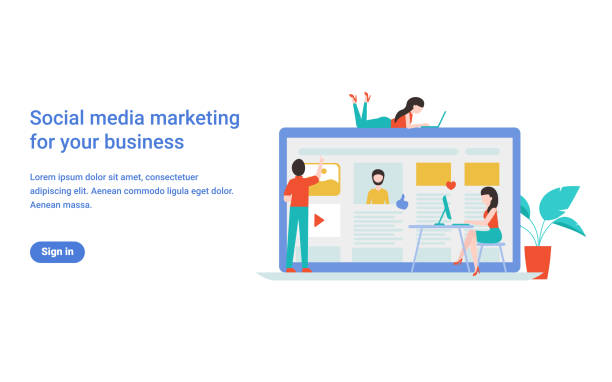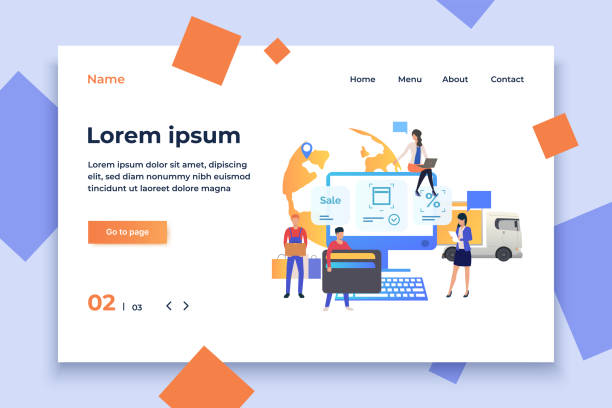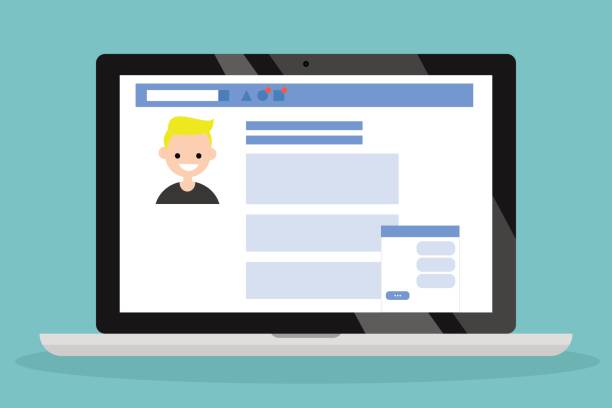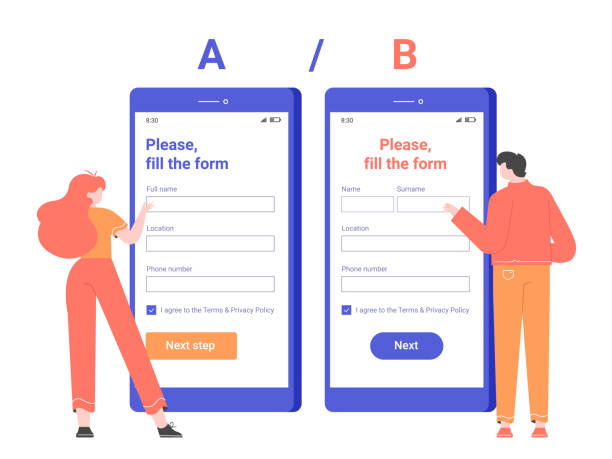An Introduction to Secure Website Design: Its Necessity and Importance

In today’s fast-paced world, an online presence is vital for every business and individual.
However, with the expansion of the digital space, security threats have also increased.
#Secure_Website_Design is no longer an option, but an undeniable necessity.
Websites, due to storing sensitive user information and conducting financial transactions, are primary targets for cyberattacks.
An insecure website not only harms a brand’s reputation and credibility but can also lead to the loss of customer data, heavy legal fines, and irreparable financial damages.
For this reason, understanding the principles of cybersecurity and implementing them in the secure website design process from the outset is of particular importance.
This preventive approach significantly helps protect sensitive information, maintain user trust, and ensure the operational stability of the business.
In this article, we will explain and educate on this topic.
Are you dissatisfied with your e-commerce website’s low sales?
RasaWeb is your solution for having a professional and high-selling e-commerce website.
✅ Significant increase in sales and revenue
✅ Easy and enjoyable shopping experience for customers
⚡ Get free consultation from RasaWeb now!
Common Threats in the Web World and Their Impact on Website Security

To achieve secure website design, we must first become familiar with the types of cyber threats that target websites.
SQL injection attacks, cross-site scripting (XSS), cross-site request forgery (CSRF), malware attacks, phishing, and denial-of-service (DoS/DDoS) attacks are just a few on this long list.
Each of these attacks has its own methods and objectives; for instance, SQL injection attacks allow attackers to gain access to databases and manipulate or steal information, while XSS can be used to execute malicious code in users’ browsers.
These attacks not only jeopardize user information but can also lead to service disruption, data destruction, or even complete control of the website by the attacker.
A deep understanding of these threats and how they operate is the first step in a comprehensive analysis for implementing effective solutions in secure website design.
By recognizing these vulnerabilities, we can implement appropriate defense systems and prevent unfortunate incidents.
Best Practices in Secure Coding and Secure Website Design

Secure coding is the backbone of a secure and stable website design.
Adhering to principles and best practices in this area prevents many vulnerabilities.
This section provides specialized guidance on details that every developer should consider.
Firstly, Input Validation is a critical step; any data received from the user must be carefully checked and sanitized to prevent the injection of malicious code or unauthorized data.
Secondly, using strong encryption methods for storing passwords (such as salting for hashing) and other sensitive data is essential.
Thirdly, Session Management must be performed securely; session tokens should be random and unpredictable and should expire after a specified period or upon user logout.
Fourthly, implementing Role-Based Access Control (RBAC) is crucial to ensure that each user only has access to resources they are authorized for.
Using modern web development frameworks that have built-in security features by default can significantly help enhance security.
The principle of “least privilege” should always be considered, meaning that each component of the system should only have access to the minimum necessary permissions to perform its function.
These foundational principles are vital for any secure website design project.
| Security Aspect | Secure Methods (Good Practice) | Insecure Methods (Bad Practice) |
|---|---|---|
| Input Validation | Precise validation and sanitization of all user inputs (e.g., using anti-XSS filters) | Trusting user input without checking and validation, direct injection into the database |
| Password Management | Hashing passwords with salt (Salting) and strong algorithms (e.g., bcrypt) | Storing passwords in plain text or using weak hashing (e.g., MD5) |
| Access Control | Using Role-Based Access Control (RBAC) and applying the principle of “least privilege” | Lack of precise role and permission definition, granting unnecessary access to users |
| Error Management | Displaying general error messages to the user and logging error details in secure logs | Displaying technical error details (e.g., file paths or database queries) to the user |
| Communications | Always using HTTPS and a valid SSL/TLS certificate for data encryption | Using plain HTTP for sensitive information transfer |
The Critical Role of SSL/TLS and HTTPS in Secure Website Design

One of the most fundamental security layers in secure website design is the use of SSL/TLS certificates and the HTTPS protocol.
This section provides an educational and explanatory overview of the importance of these technologies.
HTTPS (Hypertext Transfer Protocol Secure) is the secure version of HTTP that encrypts the communication between a user’s browser and the website server using SSL/TLS (Secure Sockets Layer/Transport Layer Security).
This encryption prevents unauthorized individuals from accessing data in transit, even if it is intercepted.
For example, when a user enters sensitive information such as their username, password, or bank card details, HTTPS ensures that this data is transmitted securely and unreadable to third parties.
In addition to security, the use of HTTPS has gained increasing importance for search engine optimization (SEO), as search engines like Google prefer websites with HTTPS in their rankings.
Proper installation and configuration of SSL/TLS certificates, and ensuring that all website resources (images, scripts, styles) are loaded via HTTPS, are key steps towards achieving secure website design and building trust among users.
Failure to use HTTPS makes the website vulnerable to eavesdropping (Man-in-the-Middle) attacks.
Research shows that 80% of customers trust companies with professional websites more. Does your current website inspire this trust?
With RasaWeb’s corporate website design services, permanently solve the problem of customer distrust and a weak online image!
✅ Create a professional image and increase customer trust
✅ Attract more sales leads and business growth
⚡ Get free corporate website design consultation
Server and Infrastructure Security in Secure Website Design

Website security is not limited to coding; server and hosting infrastructure security also play a crucial role in secure website design.
This specialized aspect involves a set of measures that provide a robust environment for the website.
Firewalls, both software and hardware, are the front line of defense against unauthorized access.
They filter incoming and outgoing traffic and block suspicious traffic.
Web Application Firewalls (WAFs) also provide a more specialized layer that identifies and stops application-level attacks (such as SQL injection and XSS).
Server Hardening involves disabling unnecessary services, changing default ports, and applying strong security configurations.
Additionally, Intrusion Detection Systems (IDS) and Intrusion Prevention Systems (IPS) continuously monitor network traffic for suspicious patterns and, if a threat is identified, issue alerts or block the attack.
Ensuring regular updates of the server’s operating system and deployed software (such as web server, database, and programming language) is also crucial, as many attacks occur through known vulnerabilities in older software versions.
These comprehensive measures provide a solid foundation for secure website design and prevent attacks via the infrastructure.
User Education and Awareness: Complementing Secure Website Design

Even with the best secure website design, the main vulnerability might be the user themselves.
This section addresses this critical aspect of security in a guiding and engaging manner.
Educating users about common risks and self-protection methods is as important as technical measures.
Teach users how to create strong and unique passwords and advise them against reusing passwords.
Encourage the use of two-factor authentication (2FA), as this method provides an additional layer of security against credential theft.
Provide warnings about phishing attacks (fake emails or websites attempting to trick users into revealing information) and how to identify them.
Also, remind users never to share their sensitive information through insecure channels (such as public emails or unencrypted messengers).
Providing educational resources, articles, or even short and engaging videos can help increase user awareness.
An informed user is the best line of defense against social engineering attacks and effectively complements efforts in secure website design.
This approach also secures the website and user data against human threats, increasing the overall resilience of the system.
Security Audits and Regular Updates in Maintaining Website Security

Maintaining website security is an ongoing process and does not end with a one-time secure website design.
This section provides a news and analytical perspective on the importance of security audits and regular updates.
Cyber threats are constantly evolving, and new vulnerabilities are regularly discovered.
Therefore, it is essential for websites to be continuously reviewed for security.
This includes regular Vulnerability Scans to identify known weaknesses, and Penetration Testing by security professionals who attempt to infiltrate the system like a real attacker.
The results of these tests help identify and fix vulnerabilities before they are discovered by real attackers.
Furthermore, Patch Management is vital; this means that all software used on the website and server (including the operating system, web server, programming language, and third-party libraries) must be immediately updated as soon as security updates are released.
Neglecting these updates can open the door for attackers.
Additionally, continuous monitoring of server and application security logs for suspicious activities is highly important.
These proactive measures ensure that secure website design is maintained over time and remains resilient against new threats.
| Audit Aspect | Description and Actions | Sample Tools |
|---|---|---|
| Vulnerability Scanning | Identifying known security weaknesses in websites and servers. | Nessus, OpenVAS, Acunetix |
| Penetration Testing (Pentest) | Simulating cyberattacks to discover vulnerabilities by security teams. | Burp Suite, Metasploit, Nmap |
| Secure Code Review | Manual or automated review of source code to find security flaws and vulnerabilities. | SonarQube, Checkmarx |
| Log Monitoring | Analyzing server and application logs to identify suspicious activities and anomalies. | Splunk, ELK Stack (Elasticsearch, Logstash, Kibana) |
| Patch and Update Management | Ensuring all software and operating systems are up-to-date to address security vulnerabilities. | WSUS (Windows Server Update Services), apt/yum (Linux) |
Disaster Recovery and Incident Response Strategies for a Secure Website

Even with the most meticulous secure website design, the probability of a security incident is never zero.
This section specializes in the importance of planning for Disaster Recovery and Incident Response.
Disaster Recovery planning means having a comprehensive plan to restore website operations to normal after a disaster, such as a major cyberattack, hardware failure, or natural disaster.
This includes regular and automated backups of website data and code, and storing these backups in secure, separate locations.
Furthermore, a procedure for restoring the website from these backups and regularly testing this process should be in place.
An Incident Response plan is a set of predefined steps that must be taken immediately after a security incident (such as an intrusion or malware attack) is identified.
This plan includes incident identification and assessment, containment (cutting off attacker access), eradication of the attack vector (removing malware or patching vulnerabilities), system recovery, and finally, post-incident analysis for lessons learned.
Having a trained incident response team and regularly practicing these procedures can minimize downtime and prevent long-term damage to the website and business reputation.
This readiness is an integral part of a comprehensive and sustainable secure website design.
Did you know that 94% of a first impression of a company is related to its website design?
RasaWeb, by offering professional corporate website design services, helps you create the best first impression.
✅ Create a professional and trustworthy image for your brand
✅ Easier attraction of potential customers and improvement of online presence
⚡ Get free corporate website design consultation
Legal and Compliance Aspects in Secure Website Design

Alongside the technical aspects of secure website design, adherence to data protection and privacy regulations is also of paramount importance.
This section, presented as thought-provoking content, delves into legal aspects that are often overlooked.
Laws such as the General Data Protection Regulation (GDPR) in Europe, the California Consumer Privacy Act (CCPA), and similar laws in other countries, set strict requirements for how personal user information is collected, stored, processed, and protected.
Non-compliance with these laws can lead to severe financial penalties and serious damage to a company’s reputation.
For secure website design in compliance with these regulations, full transparency regarding the use of user data must be present, explicit consent for data collection obtained, and mechanisms for users’ right to access, correct, or delete their personal data provided.
The question is, are businesses truly prepared to face the legal challenges arising from data breaches? Is relying solely on technical aspects sufficient, or is a more comprehensive and legal approach also needed? Adherence to these laws is not only a legal requirement but also an ethical responsibility that strengthens user trust and contributes to the long-term sustainability of the business.
This aspect is often overlooked in discussions of secure website design.
The Future of Web Security and the Role of AI in Secure Website Design
![]()
The world of web security is never static; as technology advances, threats also become more sophisticated.
This section, presented as an analytical and news piece, explores future horizons and the role of Artificial Intelligence (AI) in secure website design.
One of the most significant future challenges is the rise of AI and machine learning-based attacks that can automatically identify vulnerabilities and execute more targeted assaults.
Conversely, AI can also be leveraged as a powerful tool to strengthen cyber defenses.
AI-powered security systems can identify unusual traffic patterns with greater accuracy, detect attacks in their early stages, and even respond automatically to threats.
For example, AI can play a role in improving intrusion detection systems, log analysis, predicting future threats, and even in the process of automated penetration testing.
However, the use of AI in security also presents its own challenges, including the need for large and high-quality training data, and the risk of “adversarial attacks” against AI models themselves.
The future of secure website design will likely involve the coexistence and competition between offensive and defensive AIs.
Businesses that are already considering incorporating AI-powered solutions into their security strategies will be better positioned to counter tomorrow’s threats.
This is an exciting and constantly evolving field that requires continuous attention and investment.
Frequently Asked Questions
| No. | Question | Answer |
|---|---|---|
| 1 | What does secure website design mean? | Secure website design refers to a set of measures and practices employed to protect a website against cyberattacks, unauthorized access, data breaches, and other security threats. Its goal is to maintain the confidentiality, integrity, and availability of information. |
| 2 | Why is website security important? | Website security is vitally important for maintaining user trust, protecting sensitive information (such as personal and financial data), preventing financial losses, preserving brand reputation, and complying with legal regulations (like GDPR). A security breach can lead to customer loss and heavy penalties. |
| 3 | What are some of the most common security attacks against websites? | Common attacks include SQL Injection, XSS (Cross-Site Scripting), CSRF (Cross-Site Request Forgery), Brute Force, DDoS attacks, Broken Authentication, and Missing Function Level Access Control. |
| 4 | What is the role of SSL/TLS certificate in website security? | An SSL/TLS certificate (which leads to an HTTPS address) is used to encrypt data exchanged between the user and the website server. This prevents eavesdropping or manipulation of sensitive information, such as passwords and credit card details, during transit and verifies the website’s authenticity. |
| 5 | How can SQL Injection attacks be prevented? | To prevent SQL Injection, Prepared Statements or ORM (Object-Relational Mapping) with validated parameters should be used. Additionally, rigorous filtering and validation of user inputs (Input Validation) and applying the principle of least privilege in the database are essential. |
| 6 | What is HTTP Strict Transport Security (HSTS) and how does it help security? | HSTS is a web security policy that instructs browsers to load a website only over an HTTPS connection, even if the user enters the address with HTTP. This prevents downgrade attacks and cookie hijacking on public Wi-Fi networks. |
| 7 | What is the importance of regularly updating software and plugins for website security? | Regularly updating the Content Management System (CMS), plugins, themes, and other software components of a site is crucial for patching discovered security vulnerabilities. Developers constantly release security patches, and failing to update can leave the site vulnerable to known attacks. |
| 8 | What measures can be taken to increase the security of the website administration section (admin panel)? | Changing the default admin panel path, using strong passwords and two-factor authentication (2FA), restricting access to specific IPs, using CAPTCHA on login pages, monitoring logs, and continuous CMS updates are among these measures. |
| 9 | Why is filtering and validating user inputs (Input Validation) important? | Filtering and validating inputs help prevent the injection of malicious code or unauthorized data through forms, URLs, or other user input sections. This prevents attacks like XSS and SQL Injection that exploit invalid inputs. |
| 10 | Name some common tools or services for checking and enhancing website security. | Tools such as Web Application Firewalls (WAF), vulnerability scanners (e.g., Acunetix, Nessus), Intrusion Detection and Prevention Systems (IDS/IPS), CDN services with security features (e.g., Cloudflare), and periodic Penetration Testing can enhance website security. |
And other services of RasaWeb Advertising Agency in the field of advertising
How to use multilingual ads for global markets
Advertising placement strategies for innovative medical equipment
The role of customer support in increasing ad trustworthiness
How to use job banks with advanced search capabilities
Creating interactive ads with direct contact options
And over a hundred other services in the field of internet advertising, advertising consultation, and organizational solutions
Internet Advertising | Advertising Strategy | Advertorials
🚀 Ready to transform your business in the digital world? Rasaweb Afarin Digital Marketing Agency, specializing in SEO, content marketing, and corporate website design, offers a comprehensive solution for your online success. Contact us today for a free consultation.
📍 Tehran, Mirdamad Street, Next to Central Bank, Southern Kazeroun Alley, Ramin Alley, No. 6




